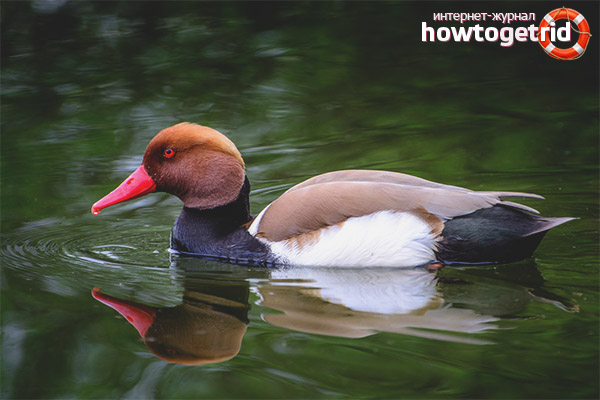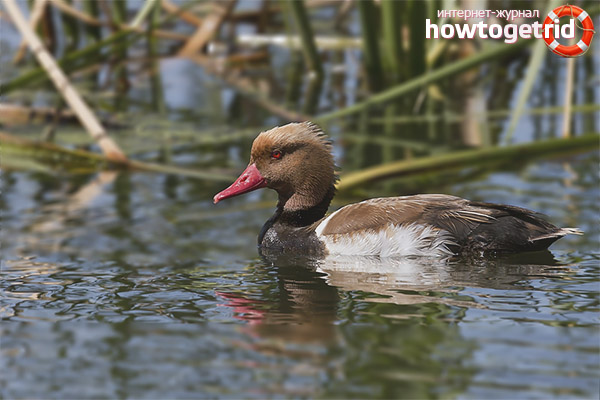The content of the article
The red-nosed duck is a fairly large bird from the order of Anseriformes, its weight reaches 1.5 kilograms. The male dive has extraordinary attractiveness in the spring, when it is time to choose a bride. On the eve of the mating season, the plumage of a feathered beauty is covered with a bright set of colors, expressed in contrasting combinations. The head of the male has a color, consisting of a very bright red color, with darker stripes in the eye area. Its beak and paws acquire a bright red hue, the abdomen and chest of the bird get a saturated black color with a characteristic tint, and snow-white oval spots loom on the wings of the dive.
The female has a more modest outfit, distinguished by its uniformity. Its plumage is painted in an inconspicuous light brown color, only the lower part of the bird and its cheeks are marked by lighter areas. In the summer, the male also prefers to put on a more modest decoration, in the manner of his girlfriend. It is distinguished by a darker bottom and a dark brown head in summer.
Individual abilities that distinguish river birds
It dives perfectly, but he does not like to dive and does it much less often than other dives, and it turns out much worse. Although, in comparison with ducks, he may seem like a virtuoso of this type of hunting. Starting from the water he is given worse than ducks, but among the dives he is the undisputed champion.
The male red-nosed dive does not like to make noise in vain, the sound he makes is more like a quiet whistle, you can hear it only in the spring. In case of danger, the dive is able to move along the water at an enviable speed, while only the bird’s neck and head are visible on the surface. The style of his swimming, he resembles a loon.
Red Nose Diving Habitats
This type of bird received its distribution from the coast of Portugal and the islands of the Mediterranean Sea, to the central regions of Asia. In Central Asia during the mating season, these birds are found in large numbers on freshwater lakes surrounded by reed beds located in the desert zone. Nests of large populations of red-nosed diving can be found in the lower reaches of the Volga and Amu Darya, as well as the Syr Darya and Tugai, in smaller quantities this bird is found in the Chu river basin or the southern part of Balkhash.
In cities of Western Europe, this bird can often be found in the park, if there is a pond in it. She is a migratory bird, and only in some cases can lead a sedentary lifestyle, abandoning seasonal flights.
The favorite habitats of the red-nosed dive are small freshwater lakes, the coast of which is covered with thickets of reeds and small shallows. Large bodies of water, like bodies of salt water, do not attract this bird at all.
Features of molting of this dive are no different from other ducks. The first draining period is molting, during this period they gather in flocks, which form on open shallows of lakes. The molting period of females comes later, during the hatching period.Having learned to fly, young individuals make their first flights between lakes, later they will have to gather in large flocks in company with adult birds that have grown new plumage.
The period of seasonal flights at the red-nosed dive lasts throughout October, until the beginning of November. Having settled down in places of wintering, these birds try to stick to open water, far from the coast, only worsening weather can force them to move to shallow water.
Diving Diet
Red-nosed dives prefer a vegetarian diet, vegetable food fully satisfies their claims in the summer. They give preference to all kinds of greenery, various algae, leaves and young shoots of plants. Going ashore, they pluck juicy stems of herbs, do not refuse fruits or berries. Being in the wintering places, dives become less legible, at which time they easily eat insect larvae, various freshwater mollusks, and in rare cases even fish. Red-nosed dives are used to eating on the water surface, and they dive very rarely and with great reluctance.
Video: Red-Nosed Dive (Netta rufina)











Submit